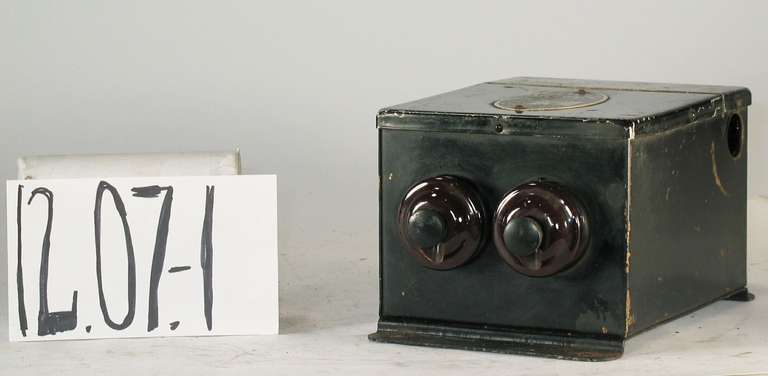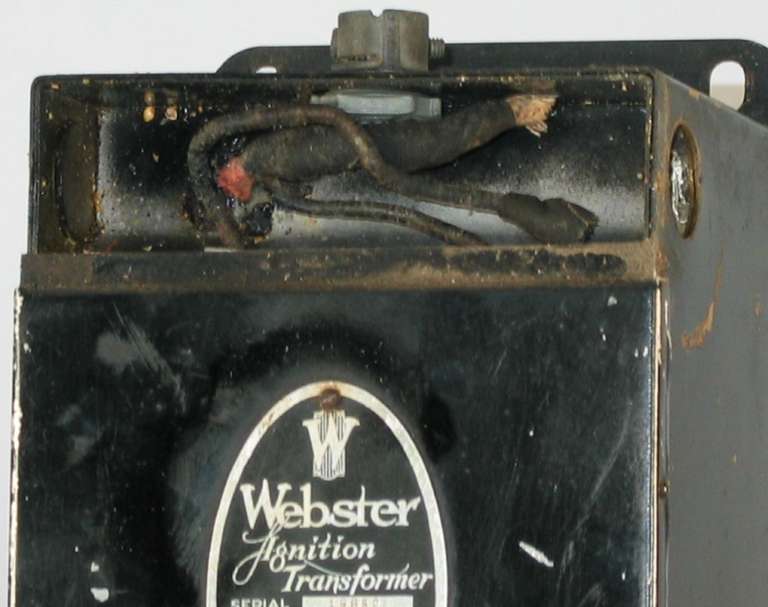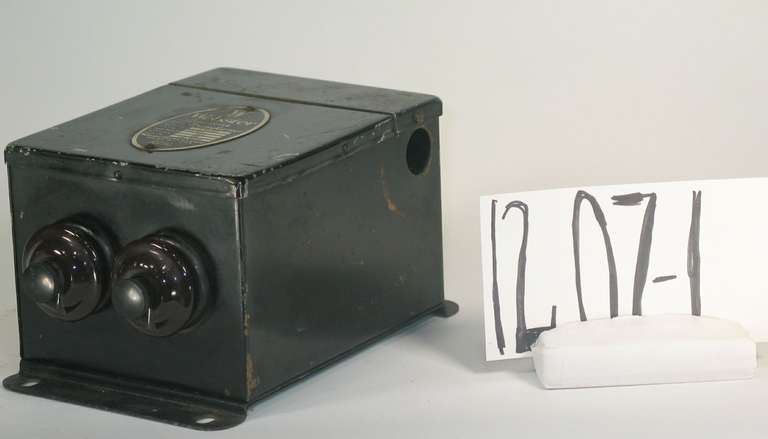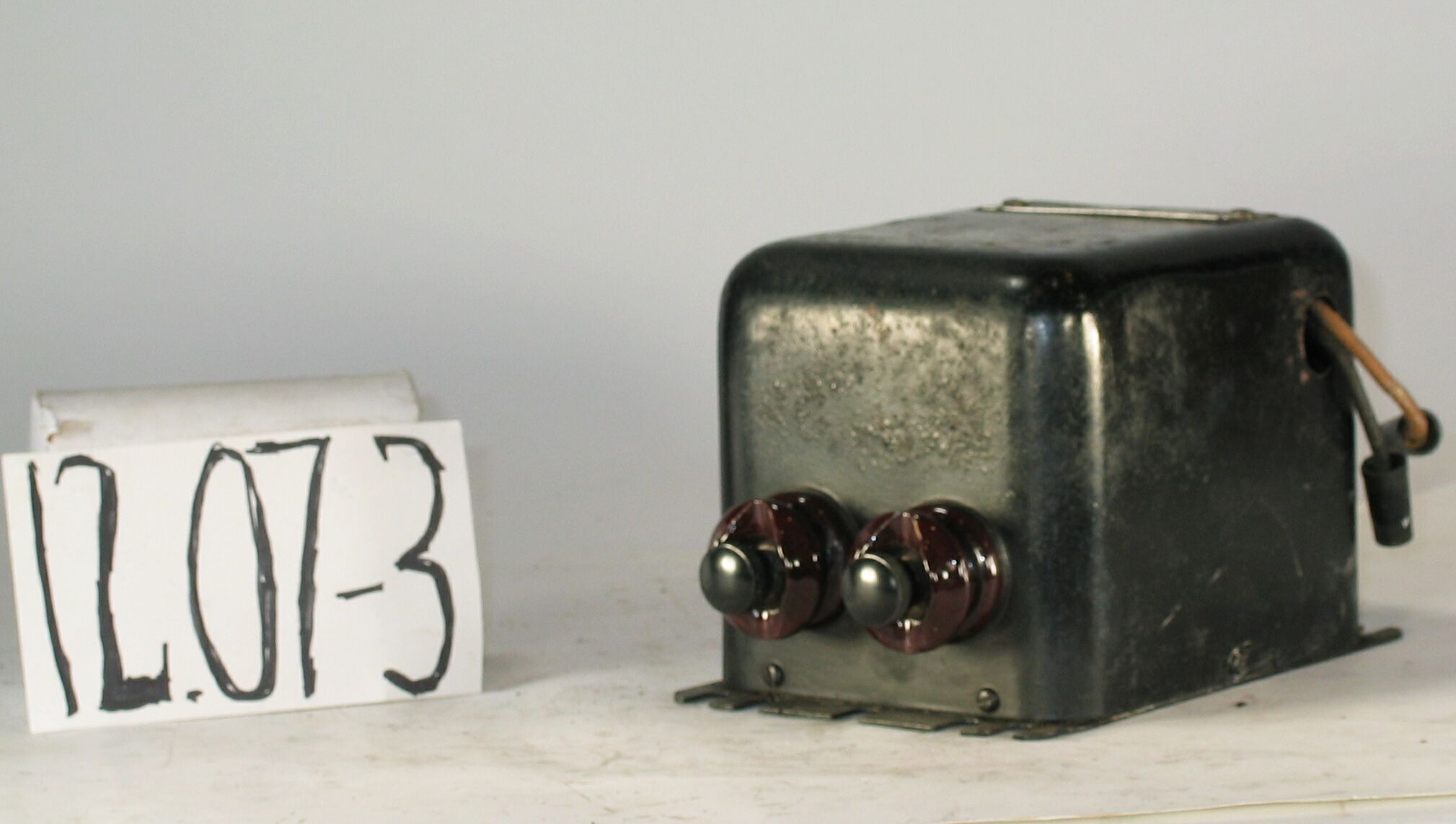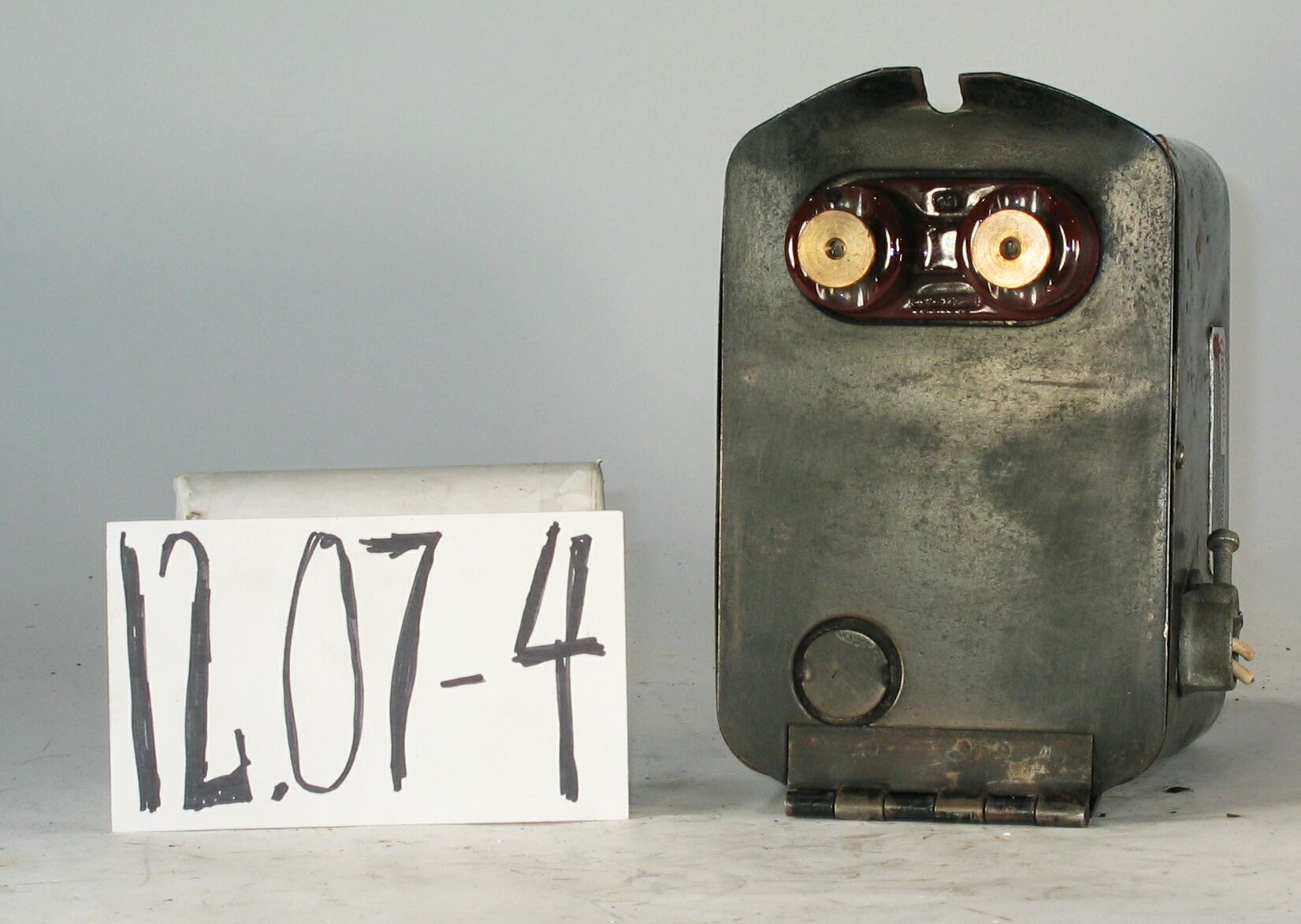12.07-1: Webster 1935 8,000 Volt, Electric Spark, Ignition Transformers
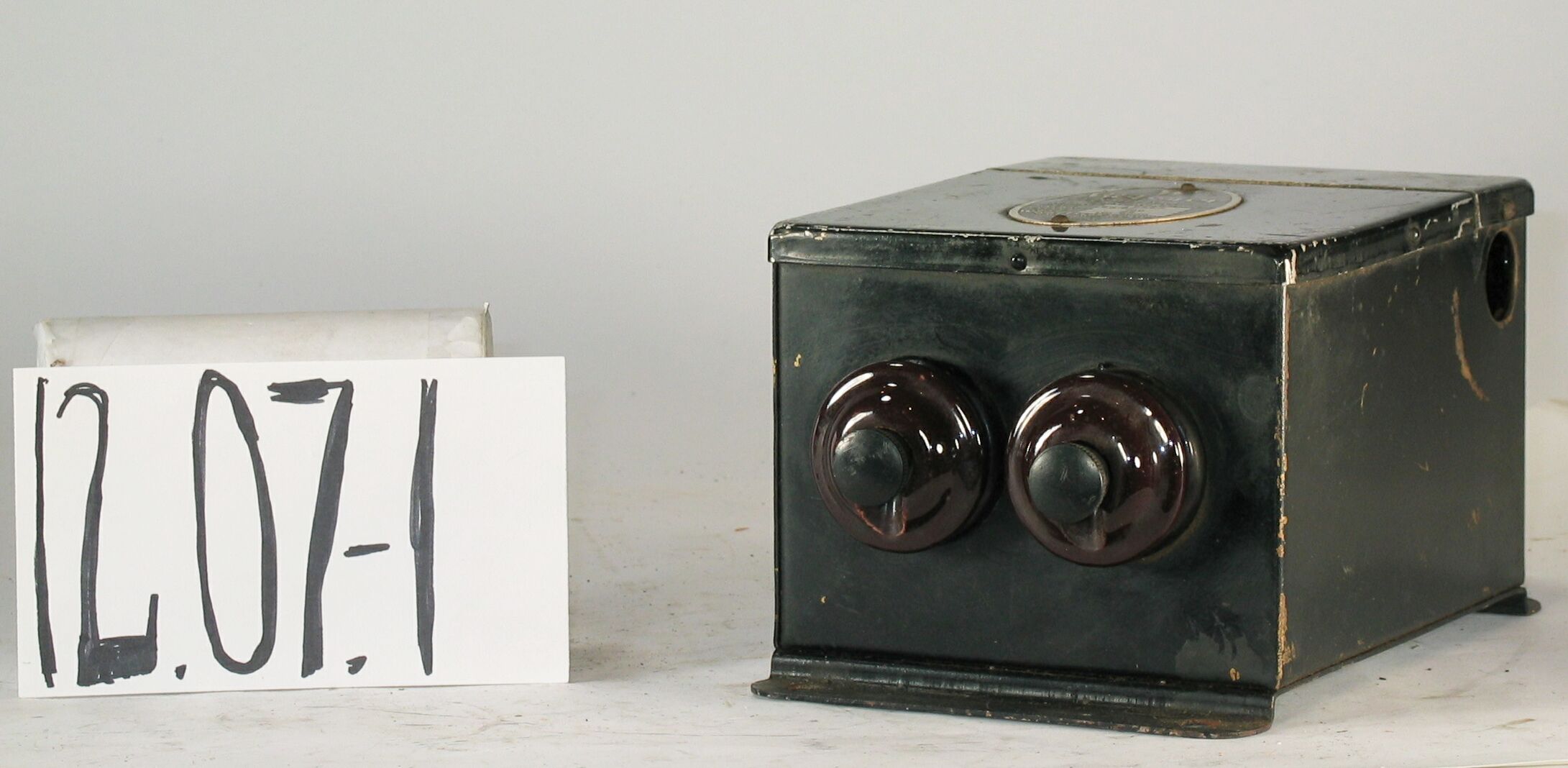
| HHCC Accession No. 2006.131 | HHCC Classification Code: 12.07-1 |
|---|
Description:
An 8,000 volt, electric spark, ignition transformers, in gloss black steel case with brass nameplate. Such devices in the home and the sparks they generated would be a source of great public mystery and often apprehension in the early years of the 20th century. Yet, they would be the true heroes of early technology for the Canadian home; without them the mechanical wonders of the period would not have been possible, the internal combustion engine, the automobile, and automatic home heating. Webster, Circa 1936:
Group:
12.07 Pressure Atomizing Oil Burner Equipment and Systems - Ignition Devices
Make:
Webster
Manufacturer:
Webster Electric Co., Racine, Wis.
Model:
20-D F
Serial No.:
19852
Size:
9 x 5 x 4 in. h
Weight:
12 ibs.
Circa:
1935
Rating:
Exhibit, education, and research quality, illustrating the engineering and design of early high voltage ignition transformers used in Canadian homes in 1920’s and 30’s
Patent Date/Number:
Patent pending
Provenance:
From York County (York Region) Ontario, once a rich agricultural hinterlands, attracting early settlement in the last years of the 18th century. Located on the north slopes of the Oak Ridges Moraine, within 20 miles of Toronto, the County would also attract early ex-urban development, to be come a wealthy market place for the emerging household and consumer technologies of the early and mid 20th century.
This artifact was discovered in the 1950’s in the used stock of T. H. Oliver, Refrigeration and Electric Sales and Service, Aurora, Ontario, an early worker in the field of agricultural, industrial and consumer technology.
Type and Design:
8,000 volt out put, 25 cycle, 110 volts, 100 watts electric ignition transformer, Chrome plated, classical cameo configured, brass nameplate, highly decorate with Fess logo, torch held high. Non ferro-magnetic, brass case, in gloss black enamel, Built in junction box Brown porcelain high tension insulators with screw terminals Base flange mounted.
Construction:
Material:
Special Features:
Original wire connector illustrating electrical trade practices of the times Chrome plated cameo styled, brass nameplate, highly decorate with logo.
Accessories:
Capacities:
Performance Characteristics:
Operation:
Control and Regulation:
Targeted Market Segment:
Consumer Acceptance:
Merchandising:
Market Price:
Technological Significance:
In a period of increasingly sophisticated mechanical contrivances, the development of electrical apparatus - including reliable, efficient high voltage ignition transformers and electric motors tended, for the most part, to lag well behind the mechanical mechanisms which they supported. The engineering and manufacturing challenge was to build an electrical transformer, to operate on 110 volts alternating current [the then accepted standard for hydro electrification in Canada], one that would create a sufficiently hot spark, about 8,000 to 10,000 volts, needed to reliably ignite an atomised oil vapor and air mixture. Little of a theoretical practical nature was known in the early years of the 20th century about the design of electrical equipment, certainly not high voltage transformers. The principles of alternating electrical circuits, as well as those of magnetic circuits were little understood, by those who must apply them. Farada’s experiments of the 1840’s and 50 had only been translated into the mathematical formula needed for precise engineering design in the 1870’s. And Steinmetz would not set out the basic parameters for the design of electromagnetic circuits until the early years of the 20th century. But the market place could not wait, engineering design proceeded empirically, with the knowledge available - with much trial and error. The toe crushing weight and size of these early specimens [15 to 20 lbs] is a reminder of the crude design criteria employed and the materials available, especially the crude dielectric materials for the insulation of wire and coil bundles operating at high potential levels. As a result electrical failure was common, with all the accompanying dangers of un-ignited explosive mixtures being pumped into the furnace fire box.
Of special significance is this, long obsolete, 25 cycle, AC specimen. Once the standard in Ontario, 25 cycle equipment was heavier and bulkier than its 60 cycle counter part.
Industrial Significance:
By the mid 1930’s the future of the Canadian oil heat industry was assured of a long period of solid growth. With hydro electrification now well advanced in many urban areas in Canada, the desire for automatic, home heating was almost universal, and with it the pressure to engineer high voltage ignition devices in Canada, at reduced cost and improved reliability and performance ‘ See ID# 256 and 257.
Socio-economic Significance:
Socio-cultural Significance:
The electrically generated spark was one of the true heroes of early 20th century technology targeted for the Canadian home and garage; without it the mechanical wonders of the period would not have been possible, the automobile, as well as automatic household heating. Yet it was a period in which electric devices of all types were viewed with great suspicion and held in awe, especially ones that would produce 10,000 volts and a spark an inch long, hot enough to ignite fuel vapour. Apprehension not-with-standing, by the mid 1930’s the future of the Canadian automatic oil heating industry was assured of a long period of solid growth. With hydro electrification now well advanced in many areas in Canada, the desire for automatic, home heating was almost universal. The high voltage ignition transformer would become a house hold fixture with all its inherent hazards - albeit an inconspicuous one.
Of cultural significance is the attention given, in this early development period of relatively crude technology, to matters of styling. The culturally sophisticated design idiom of the times is seen here in the classic cameo styled nameplate, beautifully decorated with simple classic symbolism, a hallmark of the period. The industry was clearly attempting to appeal to the interest and values of those in the population that could afford the latest technological offerings of the industry ‘ the best that the industry could provide for those with discerning Canadian tastes.
Donor:
G. Leslie Oliver, The T. H. Oliver HVACR Collection
